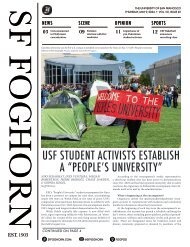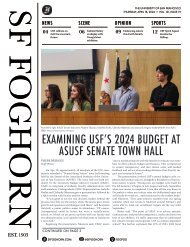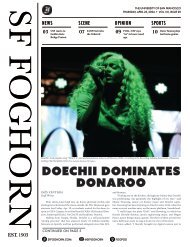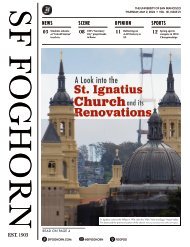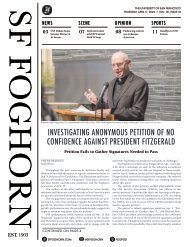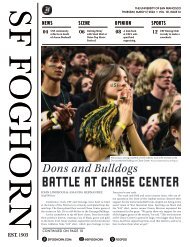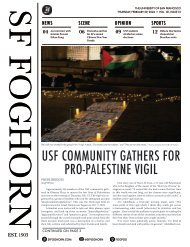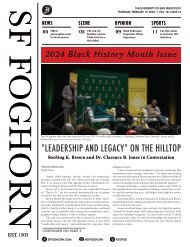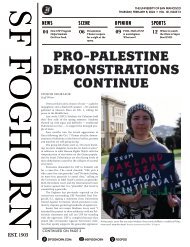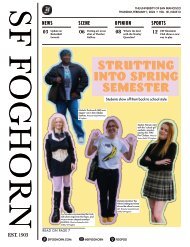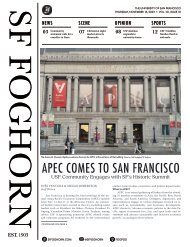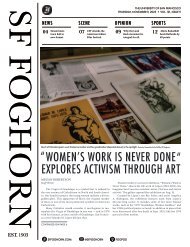You also want an ePaper? Increase the reach of your titles
YUMPU automatically turns print PDFs into web optimized ePapers that Google loves.
EST. 1903SF FOGHORN<br />
03<br />
SFFOGHORN.COM<br />
FOGPOD<br />
NEWS<br />
USF Faculty and students<br />
ask why there are so few<br />
electric vehicle charging<br />
stations on campus.<br />
SCENE OPINION SPORTS<br />
The Met Gala fashions a<br />
Finding one's identity in<br />
08 platform for discrepancies 09 Chicanx literature. 11<br />
between the country’s elite<br />
and the general population.<br />
NEW FACES IN FAMILIAR PLACES<br />
Key positions see new administrative<br />
appointments at the Hilltop<br />
Women’s soccer takes<br />
on competition down<br />
south.<br />
(From left to right): USF’s three new administrators, April Crabtree, Pamela Balls Organista, and Dr. Patricia Pearce, are excited to implement new strategies to tackle the<br />
University’s challenges and recovery efforts post-pandemic. PHOTO COURTESY OF USF OFFICE OF MARKETING COMMUNICATIONS<br />
ZOE BINDER<br />
Staff Writer<br />
@SFFOGHORN<br />
THE UNIVERSITY OF SAN FRANCISCO<br />
THURSDAY, SEPT. <strong>23</strong> <strong>2021</strong> • <strong>VOL</strong>. <strong>119</strong>, ISSUE 03<br />
This past summer, USF parted ways<br />
with former administrators and made new<br />
appointments in three key areas: Strategic<br />
Enrollment Management (SEM), the Office<br />
of Diversity Engagement, and Community<br />
Outreach (DECO), and the School of<br />
Nursing and Health Professions (SONHP).<br />
April Crabtree, who was previously<br />
hired in 2015 as the Director of Undergraduate<br />
Admission and Recruitment, took<br />
on the role of interim vice provost for Strategic<br />
Enrollment Management, succeeding<br />
Michael Beseda, who returned to his alma<br />
mater, Saint Mary’s College of California.<br />
Crabtree leads essential divisions for<br />
USF’s enrollment process and financial resources.<br />
“My role is to oversee and help facilitate<br />
decisions to make sure we are meeting<br />
service expectations for students,” she<br />
said.<br />
Under Beseda’s tenure, USF consistently<br />
received high rankings in student<br />
diversity and record admissions for this fall<br />
semester, but the University also faced enrollment<br />
challenges given the COVID-19<br />
pandemic. Crabtree’s plan for this academic<br />
year is to continue where Beseda left off.<br />
“Particularly in the last three years, the<br />
circumstances that we’re trying to work in<br />
have changed,” she said.<br />
One of Crabtree’s key responsibilities<br />
will be to maintain and increase enrollment<br />
of certain student demographics. “We are<br />
super proud that all the work we’ve done<br />
over these years has moved USF to sharing<br />
the title of most diverse institution in the<br />
country,” she said. “It was important for<br />
me in this role that first-generation college<br />
Continued on page 04<br />
students are still a priority, and Pell Grant<br />
students, since those are personal to me.”<br />
Crabtree is also concentrating on increasing<br />
international and transfer student<br />
demographics. “A major interest is regrowing<br />
our international student population,<br />
but that has been made very difficult during<br />
the pandemic,” she said. “Transfer students<br />
are also super important to USF, but we<br />
also know that enrollment is down at community<br />
colleges which has a direct effect on<br />
us.” The pandemic has posed challenges for<br />
the University’s enrollment, but Crabtree<br />
ensured that projects are underway to accelerate<br />
the process.<br />
As an interim vice provost, Crabtree<br />
will hold her position for one year. However,<br />
she said, “This role would be something<br />
that I would probably apply for permanently.”
02<br />
THURSDAY<br />
SEPT. <strong>23</strong>,<br />
<strong>2021</strong><br />
STAFF<br />
SUBMISSION POLICY<br />
The San Francisco Foghorn is the<br />
official student newspaper of the<br />
University of San Francisco and is<br />
sponsored by the Associated Students<br />
of the University of San Francisco<br />
(ASUSF).<br />
The thoughts and opinions expressed<br />
herein are those of the individual writers<br />
and do not necessarily reflect those<br />
of the Foghorn staff, the administration,<br />
the faculty, staff or the students<br />
of the University of San Francisco.<br />
Contents of each issue are the sole<br />
responsibilities of the editors.<br />
An All-American<br />
Publication<br />
ad maiorem dei<br />
gloriam<br />
The San Francisco Foghorn is free of<br />
charge, one copy per reader. To purchase<br />
additional copies for $1, please<br />
visit our office.<br />
Advertising matter printed herein is<br />
solely for informational purposes.<br />
Such printing is not to be construed<br />
as written or implied sponsorship<br />
or endorsement of such commercial<br />
enterprises or ventures by the San<br />
Francisco Foghorn.<br />
©MMIV-MMV, San Francisco Foghorn.<br />
All rights reserved. No material<br />
SAN FRANCISCO<br />
FOGHORN<br />
Freedom and Fairness<br />
415.422.5444<br />
sffoghorn.com<br />
Editor in Chief<br />
LUCIA VERZOLA<br />
editorinchief@sffoghorn.com<br />
News Editor<br />
MIGUEL ARCAYENA<br />
news@sffoghorn.com<br />
Opinion Editor<br />
CLARA SNOYER<br />
opinion@sffoghorn.com<br />
Scene Editor<br />
CALLIE FAUSEY<br />
scene@sffoghorn.com<br />
Sports Editor<br />
MAGGIE ALDRICH<br />
sports@sffoghorn.com<br />
Photography Editor<br />
BEAU TATTERSALL<br />
photo@sffoghorn.com<br />
General Reporter<br />
ANNIKA DAHLBERG<br />
reporter1@sffoghorn.com<br />
General Reporter<br />
ZOE BINDER<br />
reporter2@sffoghorn.com<br />
Managing Editor<br />
JAMES SALAZAR<br />
managing@sffoghorn.com<br />
Copy Editor<br />
NORA WARD<br />
copy@sffoghorn.com<br />
Layout Editor<br />
DOMINIQUE CADENAS CALVO<br />
layout@sffoghorn.com<br />
Layout Editor<br />
LOUISE DE OLIVEIRA<br />
layout2@sffoghorn.com<br />
Social Media Manager<br />
SAMANTHA BERLANGA<br />
socialmedia@sffoghorn.com<br />
Online Editor<br />
CLAIRE JACOBS<br />
online@sffoghorn.com<br />
Advisor<br />
TERESA MOORE<br />
2130 FULTON STREET, UC #417<br />
SAN FRANCISCO, CA 94117<br />
printed herein may be reproduced<br />
without prior permission of the Editor<br />
in Chief.<br />
Columns for the Opinion section<br />
and Letters to the Editor are gladly<br />
accepted from students, faculty, staff<br />
and alumni.<br />
All materials must be signed and<br />
include your printed name, university<br />
status (class standing or title), address,<br />
and telephone number for verification.<br />
Anonymous submissions are not<br />
published.<br />
We reserve the right to edit materials<br />
submitted. All submissions become the<br />
property of the San Francisco Foghorn.<br />
Columns of not more than 900 words<br />
should be submitted by 5 p.m. on the<br />
Wednesday before publication.<br />
Letters of 500 words or less should<br />
be submitted by 5 p.m. on the Friday<br />
before publication.<br />
Staff editorials are written by the<br />
Foghorn editorial staff and represent a<br />
group consensus.<br />
The San Francisco Foghorn Opinion<br />
page is a forum for the free, fair and<br />
civil exchange of ideas. Contributors’<br />
opinions are not meant to reflect<br />
the views of the Foghorn staff or the<br />
University of San Francisco.<br />
STAFF EDITORIAL:<br />
RECALL ELECTION AMOUNTS<br />
TO NOTHING<br />
GRAPHIC BY CLARA SNOYER/SAN FRANCISCO FOGHORN<br />
Though it was a foregone conclusion that<br />
he would keep his seat in office, the recent gubernatorial<br />
recall election of Gov. Gavin Newson<br />
was pointless for multiple reasons. The<br />
state wasted taxpayer dollars on an attempted<br />
power grab, but unlike the last recall election<br />
in 2003, which successfully ousted incumbent<br />
Gov. Gray Davis, Republicans were unable<br />
to turn California red. Additionally, the recall<br />
election encapsulated the current state of<br />
American politics as our penchant for culture<br />
wars allowed political figures like Larry Elder<br />
to step onto the scene and sow Trump-like<br />
seeds of political discontent.<br />
While he no longer holds office, the<br />
ways in which Donald Trump overhauled the<br />
Republican party are still being felt in state<br />
politics. Since Trump lost his presidency, the<br />
GOP has played into the idea of rigged elections,<br />
a sentiment that undermines the democratic<br />
process which is supposed to set this<br />
country apart from every other nation in the<br />
world. In other words, elections only count<br />
when the GOP gets its way. Even before the<br />
2020 presidential election votes were certified,<br />
Trump planted mistrust among his supporters<br />
by spewing unfounded claims of a rigged election.<br />
Candidates such as Republican frontrunner<br />
Elder tried emulating these tactics. Long<br />
before the recall, Elder came prepared with<br />
a team of lawyers and a voter fraud website<br />
that would supposedly prove that Democrats<br />
were continuing to steal elections. Regardless<br />
of their political affiliation, party members<br />
cannot cry foul when their candidate does not<br />
win.<br />
The recall election takes on another level<br />
of absurdity when accounting for the approximate<br />
$300 million California spent on the<br />
recall election, an amount reported by the Los<br />
Angeles Times. This money could have been<br />
distributed back to communities that suffer<br />
from lack of housing, little access to healthcare,<br />
and jobs that do not pay enough, especially<br />
as the COVID-19 pandemic continues<br />
ravaging the lower class.<br />
Some Californians tried to justify recalling<br />
Newsom by pointing to his own inactions<br />
toward the pandemic — he had been reckless<br />
in his personal decision of evading his own<br />
state public orders and spent a lavish night<br />
with wealthy donors as opposed to implementing<br />
real action that would exacerbate the<br />
spread of the virus in California. However, Republicans<br />
cannot claim that our current leader<br />
is not doing anything to contain the virus<br />
when their platform routinely downplays the<br />
effects of the pandemic.<br />
To make sure an election like this never<br />
happens again, Californians have to show<br />
up for themselves and, more importantly, for<br />
each other. The thought of California turning<br />
red seems far-fetched, but the state was not always<br />
a democratic safe haven. To keep California<br />
blue, we must vote with the urgency that<br />
all of this could be taken away at any moment.<br />
It is not enough to count on others to do work<br />
for us, especially when they often come from<br />
already disenfranchised communities.<br />
Secondly, the state itself needs to examine<br />
its political practices. While California was<br />
one of the earliest states to modernize government<br />
by establishing the recall election, we<br />
now see it is far too easy to go through the<br />
process and instigate a recall. 19 states allow<br />
recall elections and specific grounds for recall<br />
are required in eight of these states. California<br />
needs to adopt a more concrete plan for what<br />
is grounds for recall as failure to do so will lead<br />
to an abuse of the system. This is why California<br />
voters must not become complacent but<br />
stay in tune with the ways in which they can<br />
change or sustain the systems that govern us.<br />
MIGUEL ARCAYENA<br />
Staff Writer<br />
WHERE TO PLUG? THE SEARCH FOR<br />
ELECTRIC VEHICLE CHARGING STATIONS<br />
According to the Department of Public Safety, there are currently a total<br />
of 814 parking spaces available for the USF community to use on campus,<br />
including the recently added 83 stalls under the new Lone Mountain East<br />
dorms. Unfortunately, electric vehicle (EV) owners will only find three accessible<br />
spaces with charging stations, and these are limited to only a select number<br />
of faculty members.<br />
“Why don’t we have more chargers? There’s clearly demand for them,”<br />
said politics Professor Stephen Zunes. He drives a Chevrolet Volt Plug-In Hybrid<br />
and often commutes from Santa Cruz. When he is unable to charge his<br />
vehicle, Zunes must use gas to drive back home. Though a personal inconvenience,<br />
Zunes says the lack of options to charge his vehicle outlines a bigger<br />
issue of limited EV accommodations offered by the University.<br />
David Philpott, assistant vice president for labor and employee relations,<br />
handles the unofficial EV charging station program for USF. He wrote in an<br />
email that there is actually “no formal policy” in regards to EV charging stations.<br />
“The University established an Electric Vehicle charging station pilot program<br />
in 2017. The first 25 faculty members and staff who signed up were<br />
granted an opportunity to participate. A waitlist was established for other faculty<br />
and staff members who expressed interest in the program,” wrote Philpott.<br />
Since its introduction four years ago, the program has not expanded.<br />
Zunes remains confused as to why station access is still limited to the<br />
same 25 faculty members who signed up in 2017. “The bigger issue for me is<br />
I never see all three spaces full,” said Zunes. “Why not expand it? Why not<br />
have other people use it as well, given that they’re available most of the time?”<br />
Philpott said USF does want to increase accessibility, but the issue has<br />
been tied to recent University financial struggles. According to some estimates,<br />
the current EVlink Charging Station that is used by the University costs from<br />
$2,000-7,000. However, Philpott said “The University has always planned on<br />
expanding the program. The University has applied for several grants to help<br />
fund the expansion, and the budget cuts have prevented internal funding of<br />
the project.”<br />
Though only a few students commute with electric vehicles, some have<br />
still expressed concern over the lack of charging stations on campus. When<br />
transfer student Trevor Gross inquired about using the stations this summer,<br />
he said it was made clear to him that students couldn’t have access and that the<br />
University was working on expanding the program.<br />
Similar to Zunes, Gross observed that the spaces were not often used. “If<br />
there aren’t any faculty using them, I don’t see why they should be sitting there<br />
collecting dust when students can take advantage of it,” said Gross.<br />
Senior nursing student Danielle Hong, who drives a Tesla, agreed that<br />
an expansion on charging stations would provide some relief for students.<br />
Although she understands that it is limited to faculty use, Hong says what<br />
interests her is the University’s discreet way of acknowledging its EV charging<br />
stations. “I feel that there isn’t enough being done to even publicize the availability<br />
of charging stations on campus.”<br />
The issue of charging stations has also become a faculty bargaining issue,<br />
given that its policy is led by a member of the University’s labor negotiating<br />
team. Public Safety, which normally oversees campus parking operations, does<br />
not handle this issue, nor does the Office of Sustainability, which leads the<br />
University’s green and eco-friendly initiatives.<br />
When asked why this issue is under the University’s general counsel’s responsibility,<br />
Philpott clarified that “Labor Relations, which is under the Office<br />
of the General Counsel, was part of the initial rollout and was asked to help<br />
facilitate the communication regarding the program.”<br />
According to Philpott, “In 2016, the topic of EV charging stations was<br />
raised during bargaining with the USFFA.” Subsequently, the pilot program<br />
was then introduced to faculty members in April 2017.<br />
Since then, it has evolved into an issue of expansion. Karen Sawislak, general<br />
counsel for the USF Full-Time Faculty Association (USFFA) said, “We are<br />
hopeful that resources will be identified very soon to create new facilities and<br />
that the University will look at creative solutions and partnerships to carry out<br />
this important project. Most immediately, we are talking with the University<br />
about opening up the existing program to more of our members.”<br />
According to the USF’s Climate Action Plan, the University has a “moral<br />
imperative to act now on climate change” and is currently working towards<br />
a commitment to carbon neutrality by 2050. Though “driving less” and “reducing<br />
carbon emissions” are some of the key strategies to complete the goal,<br />
Philpott said that the University “has made numerous strides and continues to<br />
implement various initiatives to reduce our carbon footprint.”<br />
With only two charging stations that serve three vehicles, Zunes said,<br />
“With our supposed commitment to reducing carbon emissions, we’re making<br />
it difficult for something that would be so straightforward.”<br />
Given that only a handful of faculty members and students drive electric vehicles, many of them are wondering how often these chargers at the lower level of the Koret Health and Recreation Center<br />
parking lot are used. PHOTO BY MIGUEL ARCAYENA/SAN FRANCISCO FOGHORN<br />
03<br />
NEWS
04 05<br />
THURSDAY<br />
SEPT. <strong>23</strong>,<br />
<strong>2021</strong><br />
NEW FACES IN FAMILIAR PLACES • Front Page<br />
Newly named senior vice provost for Equity,<br />
Inclusion, and Faculty Excellence, Pamela Balls<br />
Organista, will now oversee the Office of Diversity,<br />
Engagement, and Community Outreach. “I started<br />
here many years ago in the psychology department<br />
and I taught in the ethnic diversities program,” said<br />
Balls Organista. “Having been a faculty member, I<br />
am particularly interested in supporting faculty so<br />
that they are able to provide good service.”<br />
Balls Organista said her responsibility is “overseeing<br />
and coordinating the intersections between<br />
diversity, equity and inclusion, as well as holistic<br />
faculty development.”<br />
She said this “is a newly envisioned position...<br />
there have been people who held different parts of<br />
what I am holding now, but what I bring to the<br />
role is my passion and values. The mission of this<br />
university brought me here.”<br />
Prior to teaching at USF, Balls Organista<br />
worked in internal medicine at the University of<br />
California, San Francisco and said she “spent a lot<br />
of time studying race, ethnicity, and culture, as well<br />
as looking at health issues in underserved populations.”<br />
She wants to incorporate her background<br />
into the work of her new role, working closely with<br />
the McCarthy Center.<br />
In addition to her diversity, equity, and inclusion<br />
(DEI) work, USF’s Institute for Nonviolence<br />
and Social Justice will now be under Balls Organista’s<br />
office. She also will handle academic planning<br />
at Star Route Farms, a property and brand purchased<br />
by USF in 2017 for $10.4 million. “What's<br />
so special about USF is that so much happens on<br />
campus, but so much learning can happen outside<br />
of the classroom,” she said. “Star Route Farms has<br />
a lot of potential for student and staff learning.”<br />
Academic planning in the SONHP will also<br />
see new leadership as Dr. Patricia Pearce was appointed<br />
interim dean of the program. Pearce, who<br />
was a nurse for 40 years, was previously the director<br />
of the School of Nursing at Loyola University New<br />
Orleans and the interim dean of Loyola’s College of<br />
Nursing and Health.<br />
Pearce described her new role as “overseeing<br />
faculty and collaborating with students and administration<br />
on a regular basis.” Pearce is replacing<br />
Margaret Baker, who held the position since 2016<br />
and is now retiring. “We are both very much servant<br />
leaders, so she and I have very similar ways of<br />
thinking about a deanship,” she said.<br />
In her first year of the position, Pearce hopes<br />
to “keep things stable while gearing up to help recruitment<br />
of students and staff.” She also anticipates<br />
challenges that may arise from the pandemic.<br />
“The challenges are always in resources; could be<br />
time, money, human resources, space resources,”<br />
she said. “As we put on new initiatives we have to<br />
tap into new resources and stay close with our collaborators.”<br />
While part of her role will be to help<br />
find a permanent replacement, Pearce says she<br />
would consider staying longer if the search is unsuccessful.<br />
More than anything, Pearce is excited about<br />
returning to campus. “I have really missed this energy,”<br />
she said. “I went to a meeting last week with<br />
nursing students who are getting their white coats,<br />
and I thought, ‘Wow, this energy could just change<br />
the earth.’”<br />
Even as USF has adapted to a modified return,<br />
the University still faces various challenges. Looking<br />
ahead, Balls Organista offered a guideline for<br />
the administration. “Our success will be how well<br />
we are able to share knowledge with each other,”<br />
she said. “To really affect change it has to be a collective<br />
effort. That’s how we move through crises.”<br />
HIGHLIGHTS FROM WEEKLY SENATE MEETING<br />
NEWS<br />
Besides receiving an update from Dan Lawson of Public Safety, Senate is preparing for representative elections this week, including tabling at UC 1st floor.<br />
PHOTO BY MIGUEL ARCAYENA/SAN FRANCISCO FOGHORN<br />
NEWS<br />
As interim administrators, Crabtree and Pearce will be partaking in finding a permanent replacement, however, both are open to staying indefinitely.<br />
PHOTO BY MIGUEL ARCAYENA/SAN FRANCISCO FOGHORN<br />
ANNIKA DAHLBERG<br />
Staff Writer<br />
During last week’s ASUSF Senate weekly meeting, Senate met with Senior<br />
Director of Public Safety Dan Lawson, as well as new candidates for vacant and atlarge<br />
senate positions prior to elections.<br />
Lawson, discussed a few new safety devices to be implemented on campus. He<br />
revealed that Public Safety has been working with the city to install a beacon light.<br />
The new light will serve as a flashing warning to caution vehicles when students are<br />
crossing the street.<br />
Senate agreed that the beacon’s prospective location should be on Turk Street<br />
and Roselyn Terrace, across from the new Lone Mountain dorms. This particular<br />
street has heavy foot traffic, with students going between classes and walking to and<br />
from the dorms. Lawson also mentioned details from a prior conversation about<br />
purchasing and staffing new shuttles. Due to current issues with staffing and budgets,<br />
the Department of Public Safety only has three shuttles in use.<br />
Additionally, Lawson laid out possible future plans for his department’s presence<br />
on campus in reference to the student-led movement to disarm Public Safety<br />
Officers and reduce patrolling of dorm buildings. This issue was addressed by a<br />
Senate resolution in <strong>Sept</strong>ember 2020.<br />
“My vision has been and currently is to listen to the students,” said Lawson.<br />
“We are looking at options currently of having one armed officer on campus but not<br />
visible unless there was an emergency and then having two unarmed officers that<br />
will rotate over 3-4 days.”<br />
Afterwards, ASUSF Vice President of Finance Berklee Jimenez led a discussion<br />
and vote over funding for the Model UN’s trip to Washington D.C. for the NCSC<br />
XLIX Georgetown Model United Nations Conference. The funding would include<br />
travel and boarding costs for 12 Model UN students and will require proof of vaccination.<br />
Senate moved to approve the budget totaling $6,009.<br />
With student representative elections taking place, a few applicants introduced<br />
themselves to Senate. Running for the freshmen class representative position, both<br />
Anagh Shetty, a finance-business analytics double major, and Julia Noel, a entrepreneurship<br />
major, were present at the meeting. Other candidates for the position<br />
include Akhnoor Sidhu and Rahul Pratap.<br />
At-large applicant Jasleen Dhillon introduced herself and her plans as a prospective<br />
Sikh Student Representative for Senate. Dhillon, a biology major, is the<br />
co-founder of the Sikh Student Association on campus. As a Sikh Student Representative,<br />
Dhillon expressed her goals of educating people on everything happening<br />
in the Sikh community. Her initiatives included addressing the prevalence of hate<br />
crime within Sikh and Punjabi communities. She also wants to pass a resolution for<br />
religious accommodation for Sikh students during holidays and standing in solidarity<br />
with Indian farmers during the farmers strike. Senate will vote for approval of<br />
Dhillon’s position at next week's meeting.<br />
Senate concluded their meeting and brainstormed possible topics of discussion<br />
for the first ASUSF Town Hall taking place Oct. 27.<br />
ASUSF Senate holds meetings every Wednesday from 5–7 p.m. via Zoom.
06<br />
THURSDAY<br />
SEPT. <strong>23</strong>,<br />
<strong>2021</strong><br />
NEWS<br />
AFGHANS IN USF COMMUNITY ADVOCATE FOR CHANGE<br />
MEGAN ROBERTSON<br />
Staff Writer<br />
When the Taliban took back control of Afghanistan Aug. 15, Afghans<br />
around the world felt the shock of the news. This impact stretched over 7,000<br />
miles and was felt right here on the Hilltop.<br />
While born and raised in California, freshman Adah Hakimi’s family still<br />
lives in Afghanistan. “We’re on the phone with them every single night,” Hakimi<br />
said. “And every night they keep saying the same thing, ‘Please get us out of<br />
here.’”<br />
The Taliban’s swift takeover of the country shocked and frightened Hakimi’s<br />
family. “When you see that flag being taken down and replaced, you just feel<br />
numb,” Hakimi said. “For not just my family but for Afghans everywhere, it was<br />
a day of hopelessness.”<br />
The political turmoil quickly initiated an international humanitarian crisis.<br />
One of the largest predicaments for the United States government was to evacuate<br />
nearly 300,000 Afghans who were associated with the American mission. The<br />
U.S. airlifted about 130,000 Afghans to eight processing centers in the U.S., one<br />
of the largest mass evacuations in history. Beginning Oct. 1, the Biden Administration<br />
will raise the refugee admissions cap to 125,000, with 35,000 coming<br />
from near East and South Asia. However these undertakings are only the beginning<br />
of a larger crisis as so few of the 300,000 are able to achieve refugee status.<br />
For those who escaped, “you don’t know where you’re going,” said Hakimi.<br />
“You could be going to Pakistan, Iran - you could be going anywhere.” Once<br />
placed in a country, refugees have no notion of whether they will even be accepted<br />
or how long they will be detained.<br />
USF linguistics professor Dr. Sedique Popal also felt connected to this crisis.<br />
During the Soviet-Afghan War, Popal said he was one of 5 million Afghan refugees<br />
who fled the country. “I didn’t come here looking for a job,” he said. “I was a<br />
professor in Afghanistan; I was very happy. I left the country because of [them].”<br />
Like Hakimi, Dr. Popal has family members in Afghanistan still struggling<br />
to leave. His nieces, now 21, “tried to make it to the Kabul Airport six times,” said<br />
Popal, “and they were beaten by the Taliban six times.”<br />
Under the Taliban’s rule, the lives of women have been threatened. Hakimi’s<br />
college-aged female cousins can no longer attend school. Suddenly, “everything<br />
has just stopped. They cannot go back,” she said.<br />
Unmarried women between the ages of 12 and 40 are being forced into<br />
arranged marriages with Taliban fighters, Popal said. For Popal’s sister-in-law and<br />
nieces, this is a great concern. “They are so scared,” he said. “There’s no tomorrow<br />
for Afghanistan if the Taliban are in power.”<br />
Both Popal and Hakimi have been active in their local communities in response<br />
to the situation. Popal, president of the Noor Islamic Cultural and Community<br />
Center in Concord, Calif., started a relief effort for thousands of Afghan<br />
refugees. His organization creates care packages, including clothing, toiletry, and<br />
houseware items, to distribute to Afghans resettling in the Bay Area. Since July<br />
30, over 200 Afghan refugees have relocated to the Bay Area and hundreds more<br />
are expected to arrive in the coming months.<br />
Over the past month, Popal’s team has received immense support. “People<br />
were so generous,” he said. “We don’t have room for any more [physical]<br />
donations.” However, he said, monetary donations are welcome via the center’s<br />
website.<br />
Hakimi also began taking donations that are rerouted to her aunt’s fiance,<br />
and his efforts to aid displaced Afghan families, providing them with food, tents,<br />
clothing, and other items.<br />
In addition to financial support, Hakimi participated in various political<br />
rallies, such as protests organized by the United Afghan Association. “Lately, I’m<br />
trying to go to every single protest that I can and get as many people to go,”<br />
Hakimi said. She encourages the USF community to march with her and “raise<br />
awareness for the people that are struggling and dying” in Afghanistan.<br />
Popal agreed that civic engagement is an essential tool to help Afghan refugees.<br />
“The biggest help that students could give is to voice concern to politicians<br />
to find a way to get these people out.”<br />
Both Dr. Popal and Hakimi would like to see more student engagement and<br />
discourse on campus regarding the crisis in Afghanistan. USF’s Middle East and<br />
North Africa club recently held a fundraiser outside the John Lo Schiavo, S.J.<br />
Center for Science and Innovation.<br />
Popal and Hakimi strongly encourage the USF community to educate themselves<br />
on the situation, to donate to relief efforts if possible, and to advocate on<br />
behalf of the Afghan people. “We need more than just the Afghan community to<br />
be talking about this,” Hakimi said.<br />
If you would like to contact your U.S. representatives about the situation in<br />
Afghanistan, text the word “CRISIS” to 52886. Message and data rates may apply.<br />
A protest organized by the United Afghan Association. PHOTO COURTESY OF ADAH HAKIMI<br />
Dr. Popal and the Noor Islamic Cultural Center have been making care packages to welcome<br />
resettled Afghan refugees in the Bay Area. PHOTO COURTESY OF SEDIQUE POPAL<br />
CALLIE FAUSEY<br />
Staff Writer<br />
MCCARTHY CENTER MURAL ILLUSTRATES<br />
PATHWAYS TO A BETTER FUTURE<br />
The Leo T. McCarthy Center for Public Service and the Common Good<br />
(LTMC) unveiled a new mural this week that encapsulates the center’s mission<br />
and values by bringing together historical imagery and symbolism alluding to<br />
a brighter future. Although USF and its students are not unfamiliar with some<br />
of the murals decorating the city, the piece will be the first large-scale mural<br />
project seen at USF in several years.<br />
The design committee, which was made up of LTMC students, community<br />
partners, staff and faculty, prompted the question: “Imagine waking up<br />
tomorrow to a re-imagined, just world. What does it look like?”<br />
For senior Priana Aquino, a public service and community engagement<br />
minor through one of the center’s programs, being on the committee was exciting.<br />
“Not only do I enjoy talking about art, I was able to be around a group of<br />
people from USF for the first time in a year and a half,” Aquino said. “The idea<br />
of community, specifically bridging community, was important to me. As we<br />
come into a new kind of pandemic life, I wanted to reflect in our mural how<br />
our concepts of community will remain the same no matter how isolated we<br />
are from each other.”<br />
LTMC partnered with Precita Eyes Muralists, a local mural arts organization<br />
and artist collective, to assist in bringing their ideas to life. After brainstorming<br />
various themes and multiple individual design drafts, the process revealed<br />
a combined “vision of different pathways all leading to a path toward<br />
equity that we are all traveling,” according to the center’s website.<br />
Derick Brown, the senior director of the McCarthy Center, said the mural<br />
captures the LTMC’s primary goal of preparing students for a successful life in<br />
public service and the center’s emphasis on connecting USF to the broader San<br />
Francisco community.<br />
“We’re the heartbeat of USF,” said Brown. “When I look at the mural, it<br />
really showcases the center, and what we stand for, what we believe in, some of<br />
the work that we have been doing but then also what we hope for the future.”<br />
The mural’s narrative according to the LTMC’s Director of External Relations,<br />
Leslie Lombre, begins with “Native Ohlone patterns that point up to<br />
Muralist Francisco Franco repaints the sky around the sun to highlight its rays. PHOTO BY CALLIE FAUSEY / SAN FRANCISCO FOGHORN<br />
the night sky and the Golden Gate Bridge with an ominous glow of the moon<br />
upon the fog, this representing the unknown or the lack of clarity that we all<br />
have when beginning a journey.”<br />
The viewer’s eye follows this journey from the foggy night sky to the Civic<br />
Center lit up in a rainbow. Pouring out of the building is a peace parade made<br />
up of a “rainbow of people” from all walks of life advocating for revolutionary<br />
love.<br />
The parade was one of muralist Francisco Franco’s favorite components of<br />
the overall design. Franco described his work with Precita Eyes and LTMC as a<br />
collaborative effort. His job was to take inspiration from the committee's ideas,<br />
stitch them into a cohesive story, and make it visual.<br />
“Creating a composition with all their ideas was the hard part,” said Franco<br />
while taking a break from repainting the mural’s sun on <strong>Sept</strong>. 14. Despite<br />
the challenges that arose, Franco ended up with a final design that he called<br />
“Bay-Area-esque.” Franco said that the Bay Area tradition of making a difference<br />
through grassroots efforts and community education, as depicted in the<br />
mural, relates to how he got to where he is now as a self-taught artist.<br />
The mural’s parade passes by a “tree of wisdom” filled with books and<br />
reaching out in all directions. The tree also features a Black Panther to represent<br />
“the Bay Area’s history of Social Justice movements and its fierce and powerful<br />
influence for change.”<br />
“There's gonna be a lot of roots coming down from the tree, to represent<br />
native roots, and also people who come here and set roots down to make the<br />
Bay a more beautiful and just community,” said Franco.<br />
One of the last additions to the piece were jazz players who represent<br />
the Fillmore’s musical history and invite the crowd to “go off the beaten path,<br />
which is necessary to create change and in discovering new frontiers.” Many<br />
pathways are featured in the mural, all leading into the light of a shining sun.<br />
The sunrays represent enlightenment and success.<br />
“Sometimes you have to go out there to stand for what you believe in, and<br />
that's depicted in the mural, but it's also what we're teaching the students day<br />
in and day out,” said Brown.<br />
Aquino also said that the mural represents everything the McCarthy Center<br />
stands for. “Everything we work for is done for those who came before us<br />
and those who will come after us, fortifying a legacy of love that will pave the<br />
pathway to equality and prosperity.”<br />
07<br />
SCENE
08 09<br />
THURSDAY<br />
SEPT. <strong>23</strong>,<br />
<strong>2021</strong><br />
THE MET GALA IS A MICROCOSM OF THE UNITED STATES<br />
JAMES SALAZAR<br />
Staff Writer<br />
HOW I FOUND MY IDENTITY THROUGH<br />
CHICANX LITERATURE<br />
SCENE<br />
For the pop culture savvy, the Met Gala is one<br />
of the most publicized parties in America. Thousands<br />
eagerly cycle through their Twitter timelines<br />
and Instagram feeds as celebrities’ extravagant red<br />
carpet looks make their rounds through social media.<br />
However, this year’s gala was memorable for<br />
all the wrong reasons: it highlighted the growing<br />
dissonance between America’s elite and the rest of<br />
the general population.<br />
The event itself, which is a fundraiser for the<br />
Metropolitan Museum of Art’s Costume Institute,<br />
has been referred to as “the party of the year” and<br />
“the Oscars of the East Coast.” Designers, models,<br />
and other Hollywood elite grace the red carpet<br />
with over-the-top looks to celebrate the opening<br />
of the Costume Institute’s annual fashion exhibit.<br />
According to the Met’s website, this year’s exhibit,<br />
“In America: A Lexicon of Fashion” is a “two-part<br />
exploration of fashion in the United States in the<br />
Anna Wintour Costume Center. It establishes a<br />
modern vocabulary of American fashion based on<br />
its expressive qualities.”<br />
The gala is normally held on the first Monday<br />
of May, but the ongoing COVID-19 pandemic<br />
forced the cancellation of last year’s event. This<br />
year, organizers enforced COVID-19 protocols<br />
such as a smaller guest list and requiring all attendees<br />
to provide proof of full vaccination and remain<br />
masked indoors unless eating or drinking.<br />
Most pictures from the event showed celebrities<br />
sans masks, but gala organizers justified this<br />
by saying that the attendees were posing outside<br />
on the steps of the famed Met Museum. Historically,<br />
photography from inside the event had been<br />
banned, as had social media for a brief period of<br />
time. However, Anna Wintour, the head of the<br />
event, changed the ban to only limiting selfies.<br />
Essentially, once the celebrities make their way inside,<br />
the party is over for the general public.<br />
Many red carpet looks were the highlight<br />
of the gala. Gemma Chan partnered with Nepalese-American<br />
designer Prabal Gurung to put<br />
together a strapless, black and silver sequin minidress<br />
with a ruffled lime train, a nod to Anna May<br />
Wong. In an Instagram caption, Chan wrote that<br />
“this year we wanted to give a nod to and pay<br />
tribute” to a person considered “the first Chinese-American<br />
film star of Hollywood’s golden<br />
era.”<br />
Lupita Nyong’o dazzled in a Versace navy<br />
and denim dress. Her makeup artist, Nick Barose,<br />
spoke to Vogue and said, “I was so inspired by the<br />
supermodels of the ’90s and Versace, so it’s something<br />
that’s second nature to me. But we didn’t<br />
want to do anything too on the nose. It's a different<br />
spin.”<br />
CL, a South Korean singer, songwriter, and<br />
rapper, also appeared in a denim gown designed by<br />
Alexander Wang. The gown was tied with a traditional<br />
Korean Hanbok knot in the front, and CL’s<br />
hair was inspired by a traditional Korean headpiece<br />
worn by queens.<br />
Other celebrities like Jennifer Lopez and Kim<br />
Petras embraced the Wild West and its pinnacles<br />
of American fashion. Lopez rocked a Ralph Lauren<br />
gown with a wide-brimmed hat, faux fur cape,<br />
and leather belt. Petras used her Met Gala debut<br />
The Metropolitan Museum of Art (“the Met”), located in New York City, traditionally hosts the Met Gala. PHOTO COURTESY OF<br />
WIKIMEDIA COMMONS<br />
to make a case for horse girls. She walked the red<br />
carpet in a Collina Strada dress which featured a<br />
3D horse head bustier.<br />
Model and activist Quannah Chasinghorse<br />
turned heads with a tribute to her Indigineous<br />
American culture. She wore a Navajo turquoise<br />
necklace and silver jewelry while also showcasing<br />
her traditional tattoos. In an interview with Vogue,<br />
the 19-year-old model said, “Reclaiming our culture<br />
is key—we need to show the world that we are<br />
still here, and that the land that everyone occupies<br />
is stolen Native land.”<br />
While the event’s looks should be acknowledged<br />
and celebrated, the elitism of the gala cannot<br />
not be ignored. Steps away from the event, a racial<br />
and social justice protest took place and resulted<br />
in some protesters being arrested by the New York<br />
Police Department (NYPD).<br />
A flyer from the protest referred to the group,<br />
called #FireThemAll on Twitter, as an “autonomous<br />
group of NYC abolitionists who believe that<br />
policing does not protect and serve communities.”<br />
The protesters’ objective was to interrogate why the<br />
NYPD is being allotted $11 billion in resources<br />
rather than distributed to Black and brown communities.<br />
In a video on Twitter, a protester says, “Black<br />
and brown people are on the brink of houselessness.<br />
We cannot go back to normal. Where was<br />
your rage last year?” The protester, later identified<br />
as Ella, was one of the at least nine people who<br />
were arrested. Ella continued by saying, “We demand<br />
free housing, we demand all political prisoners<br />
to be freed, we demand justice for our people.”<br />
Attendees such as “Pose” actress Indya Moore<br />
expressed regret over attending the event. On Instagram<br />
Moore wrote, “Being at the Met this year<br />
was cognitive dissonance. I entered and left feeling<br />
confused. But before that I felt clear. Grounded.<br />
People were protesting and arrested in the name<br />
of what so many of us who attended, care deeply<br />
about.”<br />
Additionally, hosts like Naomi Osaka and<br />
Amanda Gorman, two advocates for social equality,<br />
were selected by Vogue to anchor the event for<br />
their fashion contributions rather than their professional<br />
work. Vogue touted both hosts as women<br />
who made “their mark in fashion” through the embrace<br />
of their individual styles.<br />
This year’s Met Gala perfectly encapsulated<br />
the United States, where the elite were rubbing elbows<br />
and partaking in glitz and glamor, while the<br />
country’s middle class was being punished steps<br />
away in asking for a better and more equitable life.<br />
MELITZA ORTEGA is a<br />
sophomore English major<br />
and Chicanx studies minor<br />
Growing up Latina-American in the United<br />
States was always challenging for me because<br />
I did not know how to find my place in my<br />
community. I often felt the pressure to choose to<br />
identify as Mexican or American, even though<br />
I had never felt that I strongly represented either<br />
group. The root of this hardship often came<br />
from where I was located at a specific moment.<br />
If I went twenty minutes south of my home, I<br />
was stared at and scolded for speaking English.<br />
If I went only twenty minutes north, deeper<br />
into Arizona, the same would happen if I spoke<br />
Spanish. Sometimes I would be gawked at for<br />
being too pale, and other times, depending on<br />
where I was, people would glare at me for being<br />
too dark. As a child, having to change my language and the way I carried myself<br />
was confusing and frustrating.<br />
While I was born and raised in Nogales, a small town in southern Arizona<br />
bordering Mexico, where the majority of my community was Latinx, I had to<br />
travel almost 1000 miles to USF to finally learn more about the culture I had<br />
grown up with my whole life to find and embrace this part of my identity. The<br />
public education system in Arizona did not find room in their whitewashed<br />
curriculum to dedicate any time to Hispanic and Latinx history. Although my<br />
family did the best they could to teach me what they knew about my culture,<br />
learning how to simply survive in the United States was my family’s top priority.<br />
For a long time, I had been unaware of the historical prevalence of the<br />
Chicanx community. Because of this, I realized that it takes privilege for BI-<br />
POC individuals to find fields like USF’s English department and Chicanx<br />
studies program, both of which highlight their culture and include writers<br />
from their community in the curriculum. For the first time in my life, I was<br />
introduced to Chicanx history and powerful written works by members of my<br />
community. As a freshman in the honors college, I took a popular rhetoric<br />
course titled Rhetoric Across Borders, where our main objective was to learn<br />
GRAPHIC BY SAMANTHA BERLANGA/SAN FRANCISCO FOGHORN<br />
how rhetoric works at the borders of cultures, values, and experiences as well<br />
as age, race, gender, and ideology. The class was designed to explore and evaluate<br />
“border-crossing” rhetoric, something that resonated deeply with me. In<br />
Nogales, I was quite literally living in a world where I was constantly having<br />
to cross the border.<br />
Rhetoric Across Borders, taught by Professor Michael Rozendal, initially<br />
introduced me to Gloria Anzaldua’s writing as we analyzed excerpts from her<br />
famous book “Borderlands/La Frontera: The New Mestiza.” This is also what<br />
first sparked my fascination with the Chicanx community. As the year went<br />
on, I was excited to see Anzaldua’s work reappear in my syllabus for my Literature<br />
of Social Justice class taught by Professor Christina Garcia Lopez.<br />
This class introduced me to various Chicanx literary writers who used<br />
their words as a way to address various social inequality issues within the<br />
community. From here, my fascination grew and I then discovered that USF<br />
offered an entire minor dedicated to Chicanx Latinx studies. As I slowly discovered<br />
Chicanx women activist writers such as Anzaldua and Cherrie Moraga<br />
through my classes, I learned that Latinx literature and performance are<br />
accessible and meaningful devices to connect my community. Through the<br />
substance of these courses, instead of feeling oppressed by having to identify<br />
with only one nationality, I have learned to embrace my mixed heritage and<br />
appreciate the freedom of my cultural identity.<br />
Today, I feel great pride in being able to honor my culture after discovering<br />
Chicanx literature and the powerful narratives my people share. I feel<br />
driven to share my culture and my story with all who will listen so that generations<br />
after me will know their heritage and be able to actively embrace their<br />
roots. This is what inspired me to dive into this field of study. Not only is this<br />
something that I wish someone would have done for me, but I now realize that<br />
as part of the community, it is my active duty. We owe it to the generations<br />
who come after us to keep the culture alive through stories, values, and activism.<br />
This is what it means to me to be a member of my Chicanx community.<br />
Fellow members of the Latinx community: as we celebrate National Hispanic-Latino<br />
History Month, I urge you all to channel your roots and reimagine<br />
what your identity and heritage mean to you.<br />
OPINION
10<br />
THURSDAY<br />
SEPT. <strong>23</strong>,<br />
<strong>2021</strong><br />
DONS CRANK UP THE HEAT DOWN SOUTH<br />
DONS WEEKLY ROUNDUP<br />
11<br />
SPORTS<br />
JAMES SALAZAR<br />
Staff Writer<br />
USF women’s volleyball sought to end a seven-game losing streak<br />
while the USF men’s and women’s tennis teams hosted twenty-three Division<br />
I schools in their annual Battle in the Bay Classic. Here is your recap<br />
of the week in Dons’ sports.<br />
USF women’s volleyball welcomed the University of California, San<br />
Diego (UCSD) Tritons to the Hilltop <strong>Sept</strong>. 17. Though the team battled<br />
until the very end, the Dons fell to the Tritons by a score of 2-3.<br />
The Tritons took control of the first set, but a kill from right side<br />
Taylor Schein brought the Dons within four points (11-15). UCSD responded<br />
with a 10-3 run, and the Dons dropped the first set by a score<br />
of 14-25. Both sides traded points in the second set, but USF was on the<br />
wrong end of another run that had the team staring at an 8-16 deficit. The<br />
Tritons gradually secured another victory (19-25), and the Dons were on<br />
the verge of being swept by their opponents.<br />
Feeling the pressure, the Dons recorded five unanswered points in the<br />
third set, including an ace by outside hitter Lana Kutakhina. In the closing<br />
moments of the third set, Schein delivered yet another kill to finally put<br />
the Dons on the board (25-12) and keep the team from being swept. Midway<br />
through the fourth set, USF went on a 6-2 run that helped them win<br />
the set (25-20) and tie the game at two sets each. Unfortunately for the<br />
Dons, the Tritons found their offensive groove in the last set and downed<br />
the Dons by a score of 8-15, putting a stop to USF’s momentum.<br />
Looking ahead, the Dons will begin West Coast Conference play <strong>Sept</strong>.<br />
<strong>23</strong> when they host the Pepperdine University Waves.<br />
USF men’s and women’s tennis hosted and competed in the Battle<br />
in the Bay Classic <strong>Sept</strong>. 16-19. In the men’s singles main draw, Mitch<br />
Johnson was eliminated in the round of 32 by Timothy Sah of the Stanford<br />
University Cardinal. Phuc Huynh also made his exit in the round of<br />
32 when he was defeated by Andrew Rogers of the Pepperdine University<br />
Waves (5-7, 2-6).<br />
In the men’s doubles main draw, Huynh and Nil Giraldez were eliminated<br />
in the round of 16 by the Texas Christian University Horned Frogs,<br />
losing to the tune of 2-8. Johnson and sophomore Stevie Gould were also<br />
sent packing in the round of 16, losing to the University of California,<br />
Berkeley Golden Bears (1-8).<br />
In the women’s singles main draw, Chiho Mushika was eliminated in<br />
the round of 32 after she lost to Maria Campos of the University of Colorado<br />
Boulder Buffaloes (3-6, 1-6). Maria Martinez Vaquero advanced to<br />
the round of 16 with a straight set victory over Roxana Manu of the University<br />
of Kansas Jayhawks (6-1, 7-5). Rita Colyer also punched her ticket<br />
to the round of 16 with an epic three-set victory against Isabelle Lee of<br />
the University of Southern California Trojans (6-3, 4-6, 10-5). Martinez<br />
Vaquero lost in the round of 16 to Abigail Desiatnikov of the University of<br />
San Diego Toreros (2-6, 3-6), Colyer was also eliminated in the round of<br />
16 after a straight-set defeat at the hands of the Toreros’ Victoria Kalaitzis<br />
(2-6, 0-6).<br />
In the women’s doubles main draw, Mushika and Martinez Vaquero<br />
made it through the round of 16, beating the University of the Pacific<br />
Tigers (8-7), while Colyer and Arianna Capogrosso routed the Trojans<br />
(8-4). Mushika and Martinez were quickly eliminated by the University of<br />
Georgia Bulldogs (0-8), and Colyer and Capogrosso also exited the quarterfinals<br />
after being beaten by the Waves (2-8).<br />
SPORTS<br />
The Dons made their way down to Dallas and Waco, Texas to match up against the Southern Methodist University Mustangs and Baylor University Bears. PHOTO COURTESY OF CHRIS M.<br />
LEUNG/DONS ATHLETICS<br />
MAGGIE ALDRICH<br />
Staff Writer<br />
While San Francisco is seeing warmer<br />
weather due to change in season, the city’s<br />
temperatures came nowhere near the heat the<br />
women’s soccer team faced on their two-game<br />
Texas road trip. The Dons first travelled to<br />
Dallas to play the nationally-ranked No.<br />
24 Southern Methodist University (SMU)<br />
Mustangs <strong>Sept</strong>. 16.<br />
The Mustangs carried the advantage in this<br />
first-ever match up due to a free kick around<br />
midfield within the first 20 minutes of the game<br />
courtesy of sophomore Jasmine Vilgrain, which<br />
put SMU on the board first. The Dons brought<br />
the tempo up in the second half, where they had<br />
ten shot attempts in comparison to their lone<br />
attempt at scoring in the first half. Despite the<br />
work put in by the Dons, the Mustangs came<br />
out victorious by a score of 0-1, with their five<br />
saves leaving the scoreline stagnant throughout<br />
the remainder of the match.<br />
Three days after acquainting themselves<br />
with SMU, the Dons made their way out of<br />
Dallas and into Betty Lou Mays Field in Waco,<br />
Texas to test their fate <strong>Sept</strong>. 19 against the<br />
Baylor University Bears.<br />
Despite six attempted shots from the Bears<br />
in the first half, the opposition was unable to<br />
break through the Dons’ defense. USF took the<br />
lead when sophomore Jamesen Ward assisted a<br />
clean shot by senior Sydney Cooper. Within the<br />
first four minutes of the second half, the Bears<br />
connected with the back of the net and tied the<br />
game at one goal each.<br />
With a high game-time temperature of<br />
almost 100 degrees, the tied game came to a close<br />
due to a heat advisory. Regardless, the 1-1 score<br />
will count towards both team’s overall win-loss<br />
records since they fell within the 70 minute time<br />
mark.<br />
The Dons return home to Negoesco Stadium<br />
<strong>Sept</strong>. 25 to face the Santa Clara University<br />
Broncos.<br />
Senior Caragh Courtney prepares to return a shot during the Battle in the Bay Classic. PHOTO COURTESY OF CHRIS M. LEUNG/DONS ATHLETICS
12<br />
THURSDAY<br />
SEPT. <strong>23</strong>,<br />
<strong>2021</strong><br />
DONS' ROAD TRIP ENDS IN DEFEAT<br />
SPORTS<br />
(From left to right): Nik Kizerian (#19), Elias Thomas (#5), and Dominic Valdivia crowd in a huddle to raise the energy before their match.<br />
PHOTO COURTESY OF CHRIS M. LEUNG/DONS ATHLETICS<br />
JASON TITUS<br />
Contributing Writer<br />
In search of their first away win of the season,<br />
USF men’s soccer came up short <strong>Sept</strong>. 17<br />
against the California State University, Fullerton<br />
Titans losing by a score of 0-1.<br />
USF played defensively to open up the<br />
game as the Titans tallied the first two shots of<br />
the game. Freshman forward Nonso Adimabua<br />
took the Dons’ first shot at the twentieth minute<br />
of the contest, but he was unable to sink the ball<br />
into the back of the Titans’ net.<br />
Freshmen midfielders Ferdy Ghafury and<br />
Rodrigo Bueno also fired off their own shots but<br />
neither player was able to put USF on the board,<br />
and the contest remained scoreless heading into<br />
halftime.<br />
Coming out of the first half, Bueno and Adimabua<br />
did their best to string an attack together,<br />
but their efforts were once again stopped by<br />
Jose Espino, the Titans’ goalie. Bueno gave his<br />
third shot of the night in the closing minutes<br />
of the game, but he missed the go-ahead goal.<br />
Freshman defender Filip Kanold took the last<br />
and final shot of the evening for the Dons but<br />
was unable to break the scoreless affair.<br />
With less than a minute left in regulation<br />
time, junior defender Kevyn Lo was charged<br />
with a foul that awarded the Titans a penalty<br />
kick. The Titans slipped a shot by freshman<br />
goalie CJ Pycior and took the lead. The Dons<br />
searched for an equalizer to no avail, and the Titans<br />
hung onto their lead and victory.<br />
On the pitch, Bueno recorded a game-high<br />
three shots for the Dons, marking the third time<br />
in his career he has recorded three-plus shots in<br />
a single game. This match also marked the third<br />
consecutive contest in which Adimabua recorded<br />
at least two shots. He leads the Dons with 12<br />
shots this season. Pycior also made his collegiate<br />
debut as goalie and collected four saves on the<br />
night.<br />
USF’s losing-streak continued <strong>Sept</strong>. 19<br />
against the University of California, Riverside<br />
Highlanders. The Highlanders scored two unanswered<br />
goals within the first fifteen minutes<br />
to put themselves on the board. However, the<br />
Dons responded in rapid-fire succession with a<br />
goal of their own to trim the deficit back down<br />
to one point. The Highlanders shuttered USF’s<br />
comeback in the last three minutes of regulation<br />
with another goal, and the Dons would lose by<br />
a score of 1-3.<br />
Looking ahead, the Dons begin West Coast<br />
Conference play Oct. 2 against the Santa Clara<br />
University Broncos.




